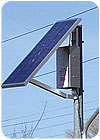
Solar-powered light poles use no utility electricity. (Photo courtesy of SOL Inc. For details, go to www.solarlighting.com.)
Drive those costs down with smarter fixtures, controls, and rates.
When searching for ways to cut a firm’s electric bill, it pays to look outside - at the lighting in the parking lot. While typically only a few percent of a facility’s total electric bill, options exist for cutting the cost of illuminating a parking area, some of which could have a big impact. As with any changes involving lighting, endusers are cautioned to ‘test before you invest’ to be sure results are acceptable.
What You Should Already Have
Parking lot light poles should already be equipped with:- High-intensity discharge (HID) lamps, either metal halide or high-pressure sodium, or electrode-less fluorescents;
- Photocell controls to keep them off during the day, and a timer to shut them down at night when the facility is closed;
- Fixtures that efficiently focus light on the ground to minimize wasted light and light “pollution.”
Improving On The Usual
Replacing standard HID lamps and ballasts in existing fixtures with pulse start magnetic ballasts and appropriate lamps may yield significant savings without cutting light level, e.g., from 450W/fixture down to ~360W (about 20%). Electronic ballasts are now available for some HID lamps that are 13% more efficient than magnetic pulse start units.Electricity consumption may be cut further by using bi-level ballasts that dim output and wattage up to 50% when controlled by motion sensors on light poles. When movement is sensed, lamps immediately return to full light output. One system is designed to communicate between poles so that motion sensed by one pole turns up not only its own lamp but “tells” others nearby to do so, even if they have not yet also detected motion. This may be done for all lights in a parking lot, or specified zones within it.

PV Also An Option
A more significant development is the use of photovoltaic (PV) panels which, when combined with batteries built into the light pole, completely eliminate need for utility power. This is not, however, a retrofit option: complete replacement of light poles is necessary to accommodate the higher wind loading of the PV panels, and to hold the batteries (which provide a five-day power reserve). While cutting energy costs may be one goal, another major selling point of this system is the avoidance of running underground power lines to light poles. As such, it is designed for new lots that may be distant from a power line. Here’s the magic number: if much of the parking lot will be more than about 1,200 to 1,500 ft from the nearest utility electric service, the cost of the self-contained PV light poles may be less than the total cost of standard light poles and the power wiring needed to run them.First, Check Power Price Options
Before embarking on any of these upgrades, examine the rate structure for the electric account covering the parking lot lighting. Doing so will ensure proper calculation of energy cost savings due to an upgrade, and possibly reveal rate-based savings that may be available before upgrading.If power is being provided from an adjacent building, the parking lot lighting probably does not contribute to that building’s monthly peak (which likely occurs during midday). Using the building’s average power price could distort savings calculations because that average would include the building’s peak demand charge (which, in some areas, could be ~50% of the total bill). Only the incremental usage charge should be applied in such calculations or, if a time-of-day rate applies, use the off-peak rate.
If the parking lot electric service is on a separate account, look for ways to change its rate (where such latitude exists) to a time-of-use or real-time pricing rate. The cost of off-peak consumption may be significantly lower than under the standard tariff. In a deregulated market, seek separate pricing - based on the hourly load profile of the lot’s power use - rather than aggregating the lot’s pricing with other accounts. A lower price may be secured.
When the lowest possible power price is in hand, use it in payback calculations to determine if investing in upgrades indeed makes economic sense. ES
Audin is president of Energywiz, Inc. (www.energywiz.com), a New York-based consulting firm that helps commercial/industrial clients get the most out of the competitive energy market. He was formerly energy manager for Columbia University and founded the New York Energy Buyers Forum.ES



